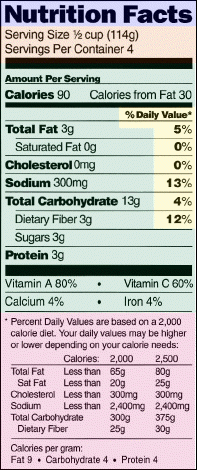
The new food label is an effort to simplify and encourage the use of nutritional information. It's clear, informative, and detailed, providing everything a consumer would normally need to decide if a food meets their nutritional standards before buying.

Nutrients
The common nutrients, such as Total Fat, Cholesterol, and Sodium, are required fields. Other nutrients, such as Iron and Vitamin K, are optional and not required to be listed.
Serving Size
Serving size tries to reflect the amount a person can eat. It must be about the same for like products, which makes it easier to compare the nutritional qualities of related foods. Serving sizes are expressed in both common household and metric measures.
Percent Daily Values
"% (percent) Daily Values" tell the levels of important nutrients in a food and how those amounts fit into a daily diet. %Daily value is determined on the basis of a 2,000 calorie diet (see below on the label). For example, the total fat of a product is 3 g, and the 2,000 calorie diet permits 65 grams a day. A simple math procedure would consist of 3g / 65g x 100% = 4.62% or about 5%, which the food label lists. So, now instead of making all the calculations, the % Daily Value column has all the answers. It simply states that the given food contains 5% out of 100% of a daily value.DRV Footnote
This footnote reminds consumers of the daily intake of different foods depending on their caloric needs. If one pursues a 2,000 calorie diet, he/she must eat the indicated amounts noted on the right of nutrients noted on the left side of the footnote. For example, if Anne's daily calorie intake is 2,500 grams, her RDAs would be -- 50g of fat, with less than 25g of saturated fat and less than 300 mg of cholesterol, etc. Kelly's calorie intake is 3,000 grams, she's slightly more active than Anne. Therefore, her nutrient needs will may be slightly higher. That is what is meant by the phrase "your daily values may be higher or lower depending on your caloric needs."
The regulations also spell out what terms may be used to describe the level of a nutrient in a food and how they can be used. These are the core terms:
Synonyms for low include "little," "few," and "low source of."
The term "light" still can be used to describe such properties as texture and color, as long as the label explains the intent-for example, "light brown sugar" and "light and fluffy."